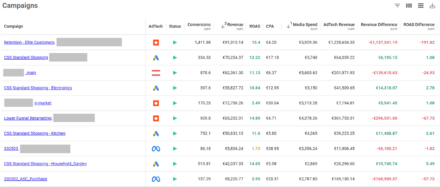Why You’re Seeing Too Much Direct Traffic in Your Analytics Reports (And How to Solve It)

Analytics are foundational for digital marketers: they have become essential elements of our daily, if not hourly, routines as reference points on performance.
But sometimes the information we receive can do more harm than good for our ongoing strategies.
One key analytics issue that consistently puzzles performance marketers is the high volume of direct traffic we can often see in our analytics tools.
In this blog, we attempt to unravel why that is happening, how you can solve this and get to a better form of attribution – and some of the benefits that can bring.
What does direct mean in Google Analytics?
Let’s kick off with a definition for context.

But before we jump into how Google defines direct traffic its important to point out that, for the purposes of this article, we are using Google Analytics as a case study largely because of its prevalence in the marketplace.
But many of the challenges and issues extend to other analytics packages whether standalone like Adobe Analytics or integrated solutions like HubSpot Analytics or other CRM or automation tools.
Google’s definition of direct traffic
Turning to Google’s own description of direct traffic:
“a session is processed as direct traffic when no information about the referral source is available, or when the referring source or search term has been configured to be ignored”.
So effectively, Google will place traffic in direct when it lacks enough information to place it into other channels such as Organic or Paid.
This could be for a number of reasons including the fact that the user typed a URL directly into the search bar, problems with tracking code on the incoming traffic or referral sources deliberately being set up to be ignored.
The problem this approach is that Direct has become a dumping ground for traffic that Google simply can’t classify.
And every marketer will identify with huge direct figures that would imply the strength of other brand activity that simply never feeds through into opportunities and pipeline.
Why is my direct traffic so high?
There are potentially a number of reasons why Google Analytics is displaying too much direct traffic in your reports.
Here are just some that we typically come across:
1. Problems with tracking code
It is highly likely that problems with tracking are a big contributor to unusually high stats in your Google Analytics direct figures.
It can happen for a number reasons from missing tracking script on certain pages to external automation tools in your tech stack not being properly set up to integrate with GA.
Regardless, this type of traffic goes into the direct traffic in Google Analytics when it clearly isn’t.
2. HTTPS – HTTP issues
This one is happening less and less as more sites move over to HTTPS but it is still worth noting.
When a user clicks through from a secure HTTPS site to an HTTP site no referral data is passed over.
This is something that is inherent in the protocol and traffic on these types of journeys is simply bundled into direct traffic.
3. Social channels not passing referral data to GA
This is sometimes referred to as “dark” social and happens when social shares can’t be properly tracked and attributed.
This applies, for example, to links that are shared in messaging apps like WhatsApp, Facebook Messenger etc which don’t include tracking and go into direct traffic as a result.
4. Links in non web documents
The same principle applies to links that are contained in embedded documents like Adobe PDFs (think research papers and ebooks), Word and Google Docs. None of these pass on referrer data and fall into direct as a result.
It’s important to note that this isn’t designed to be an exhaustive list.
It is highly likely that there are a host of other reasons from issues with cookies to UTM mapping problems. What is important is the principle that traffic – and, in our experience a considerable amount of it – is going into the wrong bucket.
Although, as we will see next in the next section the problem extends to incorrect attribution across other channels like paid ads and paid social.
How do you solve incorrect direct traffic categorisation?
At this point, it would be easy to get into a shopping list of checks that you can run through to move traffic which is wrongly categorised in the direct bucket to other channels inside Google Analytics.
While this may well be a piece of work you should undertake – troubleshooting tracking scripts, ensuring UTM tracking is properly configured etc – and it may move your analytics view forward, n many ways it is simply tinkering around the edges of what is a much wider and more strategic problem.

First up, regardless of what you think your Google Analytics view is telling you, in our experience it generates data this is up to 80% incorrectly attributed as shown in the client example on the right.
We take a more detailed look at the issue in our Complete Guide to Marketing Attribution ebook. But in a nutshell, the very nature of the way that Google collects digital marketing data is problematic because it is based on a session-based approach (cookie/pixel tracking) where a device accesses a web property rather than identifying an individual user who uses multiple devices on their buying journey.
So, while ensuring that direct traffic is properly categorized in your GA set up is important, to be effective and to have an impact it has to be part of a much wider approach that includes:
- Rebuilding your data – like any other good system the quality of the output relies heavily on what you feed in the front end. So look for attribution solutions that rebuild your data from the ground up.
- Unifying your data – getting rid of the data silos that are obscuring the true view of your marketing effectiveness by unifying on and offline data across store locations, outdoor, third party ‘walled garden’ digital data such as data from Facebook, Google Ads or YouTube.
- Effective attribution for all traffic – use the vastly improved data you now have to unravel the complexity of the wide variety of touchpoints on individual customer journeys and accurately attribute the correct level of impact to each.
What are the benefits of solving your broken attribution?
If you get this right you can expect a number of benefits including:
Get a true picture of the effectiveness of your marketing activities
In an environment where customer journeys are increasingly undertaken across a complex range of media touchpoints, both on and offline and across a multitude of devices including smartphones, tablets, work and home PCs, and mobile, effective attribution enables you to bring together the data silos across this complex environment to define a single, data-driven view of the customer journey.
The ability to link marketing spend directly to revenues
This is non-negotiable now.
The pressure for marketers to spend accurately, efficiently and to prove marketing effectiveness in driving growth is greater than ever. And is only going to intensify, so directly tying activity to revenue is no longer a “nice-to-have”. It’s essential.
Prove the value of marketing to the business
More effective attribution builds credibility and trust with the key stakeholders closest to the marketing function including the boardroom, finance – and, perhaps most importantly, sales. Securing the buy-in needed to support your marketing vision and fast-track future plans.
Improve marketing ROI
Ultimately, effective attribution helps you drive improved marketing ROI by finding the parts of your program that are working – and those that are not.
This then allows you to redirect spend to where it is going to have the biggest revenue impact.
Take the example below where QueryClick was able to create a clearer picture for our client which showed that:
- Actual attributed revenue from Facebook campaign activity was 68% less than being reported by Google Analytics
- 34% of spend was not optimal and could be reallocated to generate an additional £1.6m p.a.

We started this blog by identifying a clear issue with overstated traffic in the direct channel inside Google Analytics for a wide variety of reasons from tracking code issues to problems associated with “dark” social traffic.
While sorting out the practical issues associated with erroneous categorisation of some of the traffic that finds it way into the Google Analytics bucket by default is important to consider.
It is a microcosm of the wider issues around data quality, rebuilding and the need for an accurate and effective attribution view of your marketing activities.
If you would like to delve into the issues raised here some more then download a copy of our Complete Guide to Marketing Attribution which explores:
- why effective attribution matters more now than ever
- the types of models and why they’re broken
- how to collect and integrate accurate data
- models that are effective for today’s marketing ecosystem
- how to drive ROI with visit-level attribution
The Complete Guide to Marketing Attribution
Download your copy.
Own your marketing data & simplify your tech stack.
Have you read?
Chrome’s announcement on dropping cookie opt-in last month closed the door on a 5 year saga for marketers. But what is the landscape like in 2025 for cookie-based measurement?
Generative AI is transforming the way that marketers plan and assemble content for their Paid Ads. As big platforms like Google, Meta and TikTok increasingly build the tools needed to...
In a surprising move that has sparked heated debate, Mark Zuckerberg announced on his Instagram that Meta will be reducing its levels of censorship and in particular fact-checking on its...



